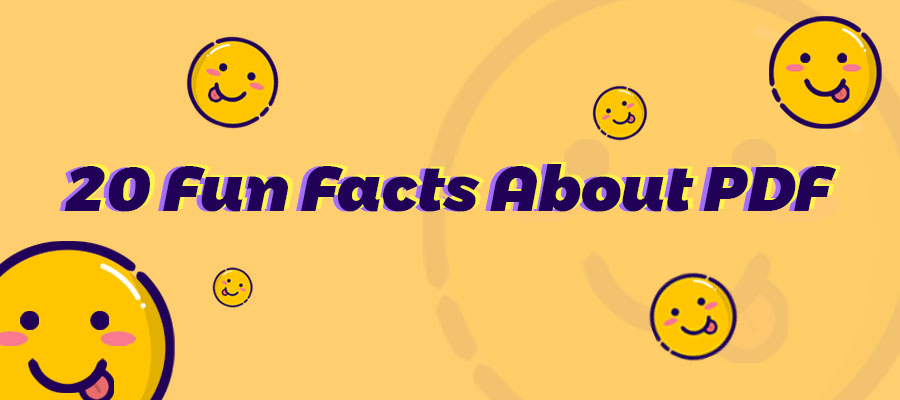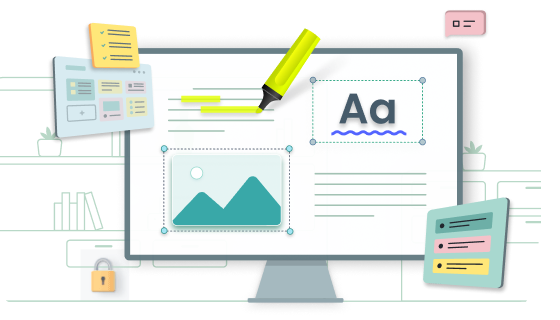
What is a PDF
A PDF, short for Portable Document Format, was introduced by Adobe in the 1990s to serve various purposes. It encompasses a plethora of editing features including images, hyperlinks, text, videos, forms, and interactive buttons. Maintained by the International Organization for Standardization (ISO), the PDF format offers multiple avenues for access. Whether through web browsers, third-party applications, or Adobe Acrobat Reader, PDFs are universally accessible across macOS, Windows, and mobile platforms. Additionally, dedicated PDF readers such as Adobe Acrobat and built-in readers in browsers like Mozilla Firefox, Microsoft Edge, and Google Chrome offer efficient and speedy performance for viewing and editing PDF files.
Next, let's take you through 26 facts about PDF.
Basic Facts:
- The full name is Portable Document Format with the filename extension as .pdf.
- The format is developed based on the PostScript language.
- Developed by Adobe Inc. from 1998 to 2008, PDF was standardized as IOS 32000 in 2008. Before that, companies who want to make, sell, use, distribute, and develop PDF-compliant implementations need to pay patent royalty to Adobe as PDF was a proprietary format.
- Its initial release was on 15 June 1993. Up to now, it has been introduced to the public for 27 years.
- PDF squeezed in the document management industry with major rivals like DjVu, Envoy, Common Ground Digital Paper, Farallon Replica, and Adobe’s PostScript format.
- There are altogether 5 potentially competitive technologies for PDF, including core w3c technologies (HTML/CSS/JavaScript), OOXML-based technologies (Microsoft universe), other document formats (DjVu, EPUB, Pages), image formats (TIFF, PNG, JPEG), and non-electronic (paper, fiche, film)
- PDF can be extended to other similar formats specializing for different purposes, including PDF/A (archiving), PDF/E (engineering), PDF/UA (user accessibility), PDF/VT, and PDF/X (graphics exchange).
- PDFs can be divided into two categories: native PDFs: generated from an electronic source document such as accounts production software, Word, Excel, HTML, Adobe InDesign, and computer-generated reports; scanned PDFs: generated by converting physical paper documents into electronic form with a scanner.
- In addition to Adobe Acrobat, many available PDF tools exist in the market that enables users to view PDFs. With built-in plugin components, many browsers allow users to view PDFs for free, such as Mozilla Firefox, Safari, Google Chrome, and Microsoft Edge. However, users can only view the PDF document on these platforms, without any further actions can be done on browsers. Please turn to professional PDF tools if you need to make changes to PDF files, and SwifDoo can help.
- Similar to other e-files, PDFs can possibly get corrupted, especially when PDFs are created, saved, and downloaded. A corrupted PDF document can be repaired with professional recovery tools. You’d better backup important PDF documents when necessary.
- Originally, PDF was born for cutting down paper usage and helping build a paperless office. Now, PDF is an indispensable component in going paperless for every company.
- Accessibility, ease of use, and reliability have brought PDF to the forefront and made it an integral part of daily life. The US tax authorities were the first important agencies to try PDFs because of their nature to ensure the unchanged layout or content of PDFs.
- It was firstly found in 2001 that PDFs could carry computer viruses. The worm, the OUTLOOK.PDFWorm or Peachy was hidden in PDF files. When you open PDF documents using Adobe Acrobat, this virus was triggered. Then, this PDF document would launch a game forcing users to click on the image of a peach. Any Adobe Acrobat users who opened this PDF became vulnerable to the virus. But this worm was triggered under certain conditions: users used both Microsoft Outlook and the full Acrobat program (not only the Reader).
Statistical Facts - In April 2016, 2.2 billion PDF files were found on the public web.
- 20 billion PDF files were stored in Dropbox in 2016.
- Large companies and departments tend to have millions of PDFs stored in their database, for instance, Airbus, Boeing, and the US Department of Justice had over 1 billion PDFs respectively.
- 2 billion PDFs were opened every year on Outlook.com.
- 73 million new PDF files were saved every day in Google Drive & Mail in 2016.
- 60% of non-image attachments were PDFs in Outlook Exchange Enterprise.
- In April 2018, PDFs accounted for 85% of document formats on Bing, while the figures were 10%, 3%, and 2% for DOCx, XLSx, and PPTx respectively.









